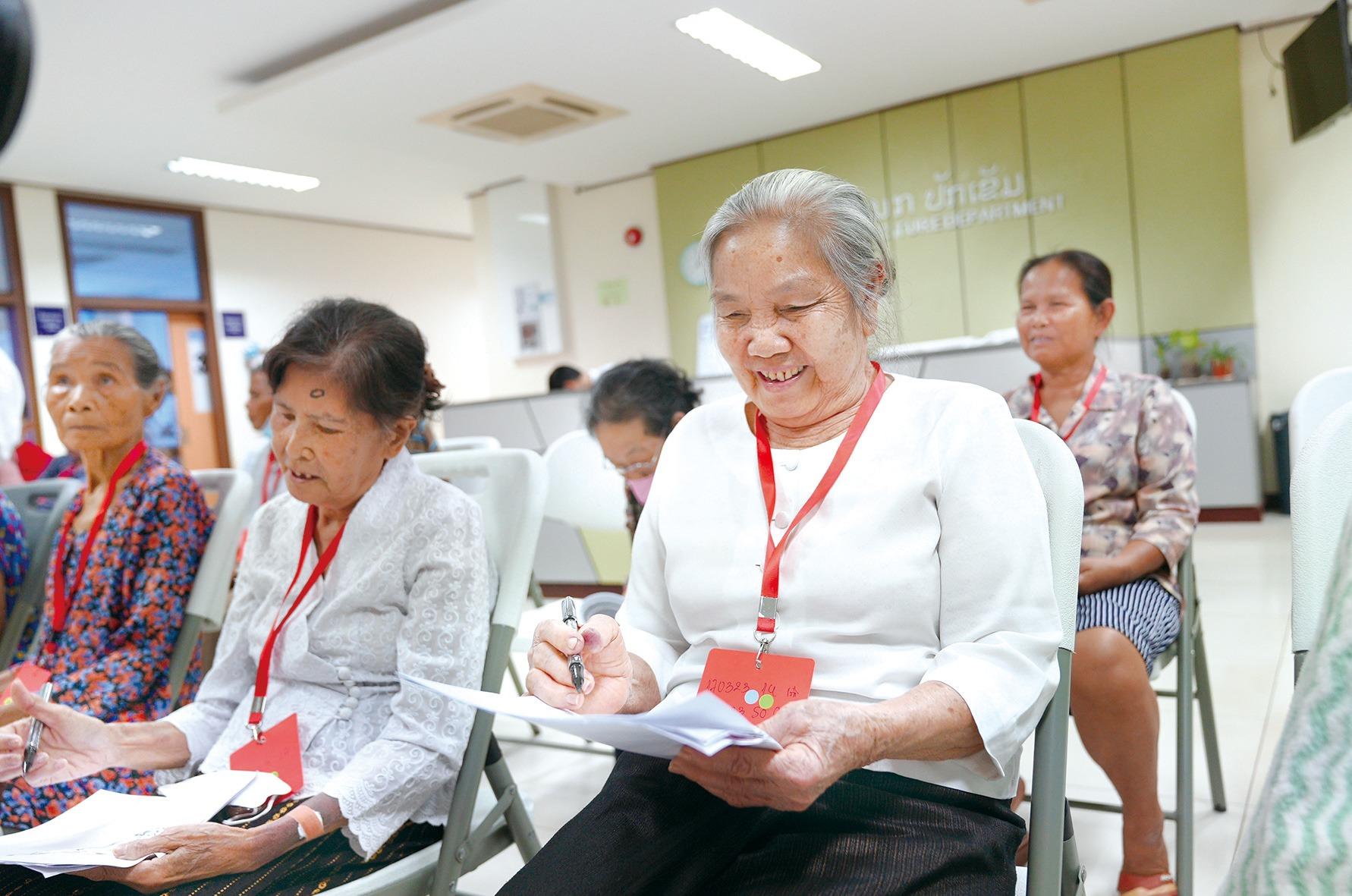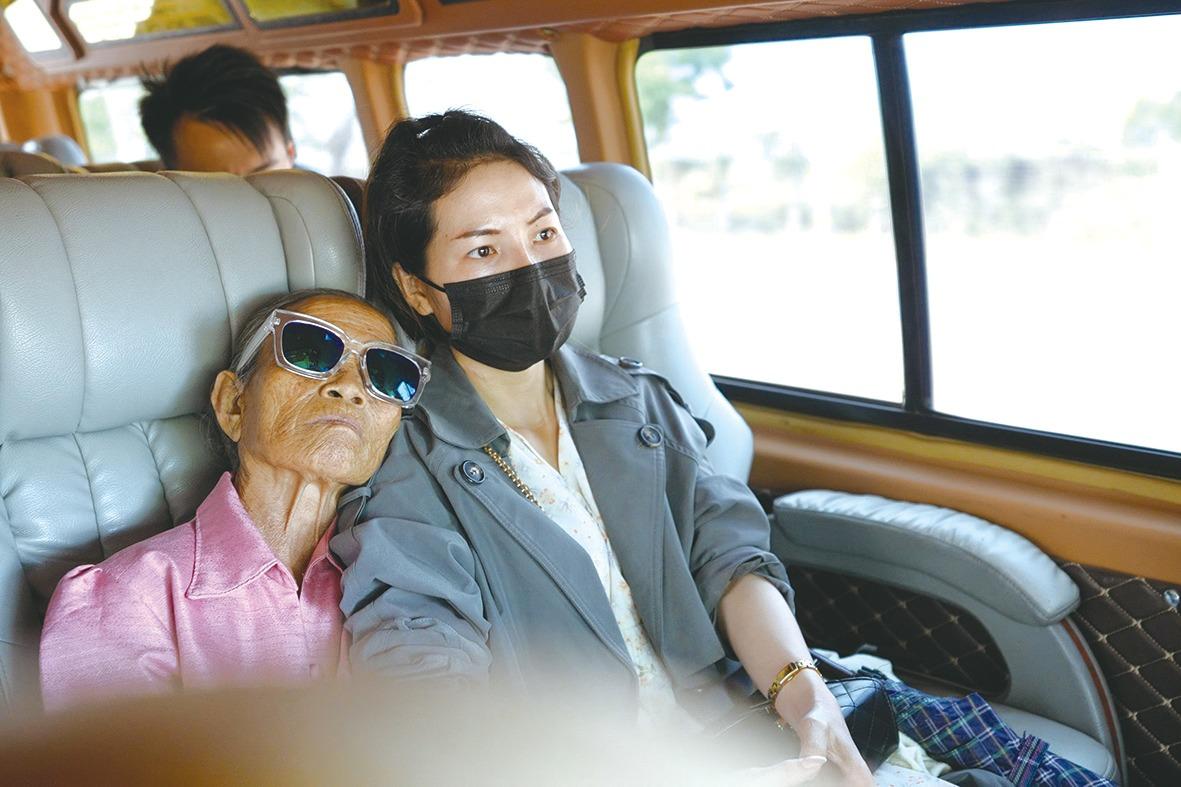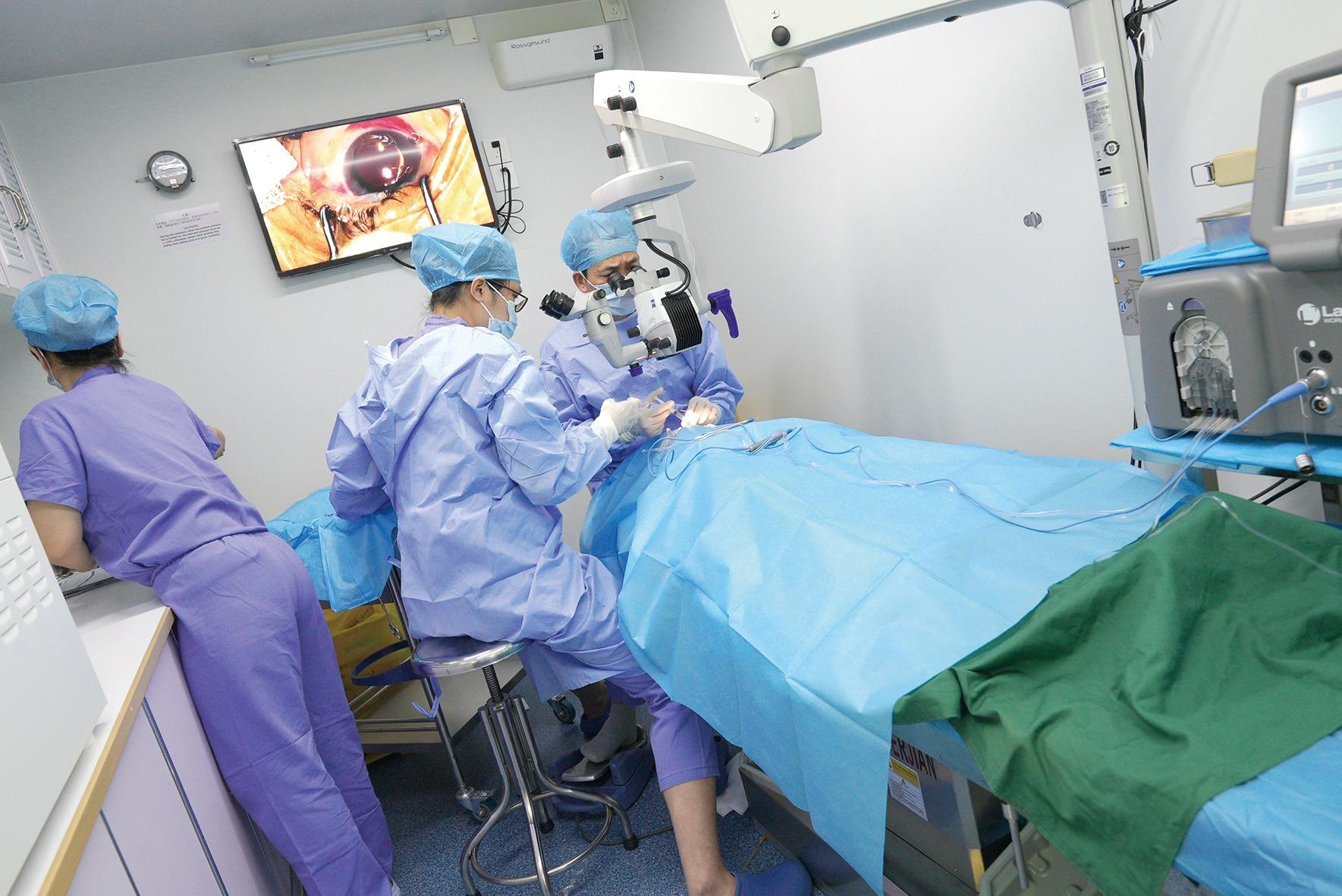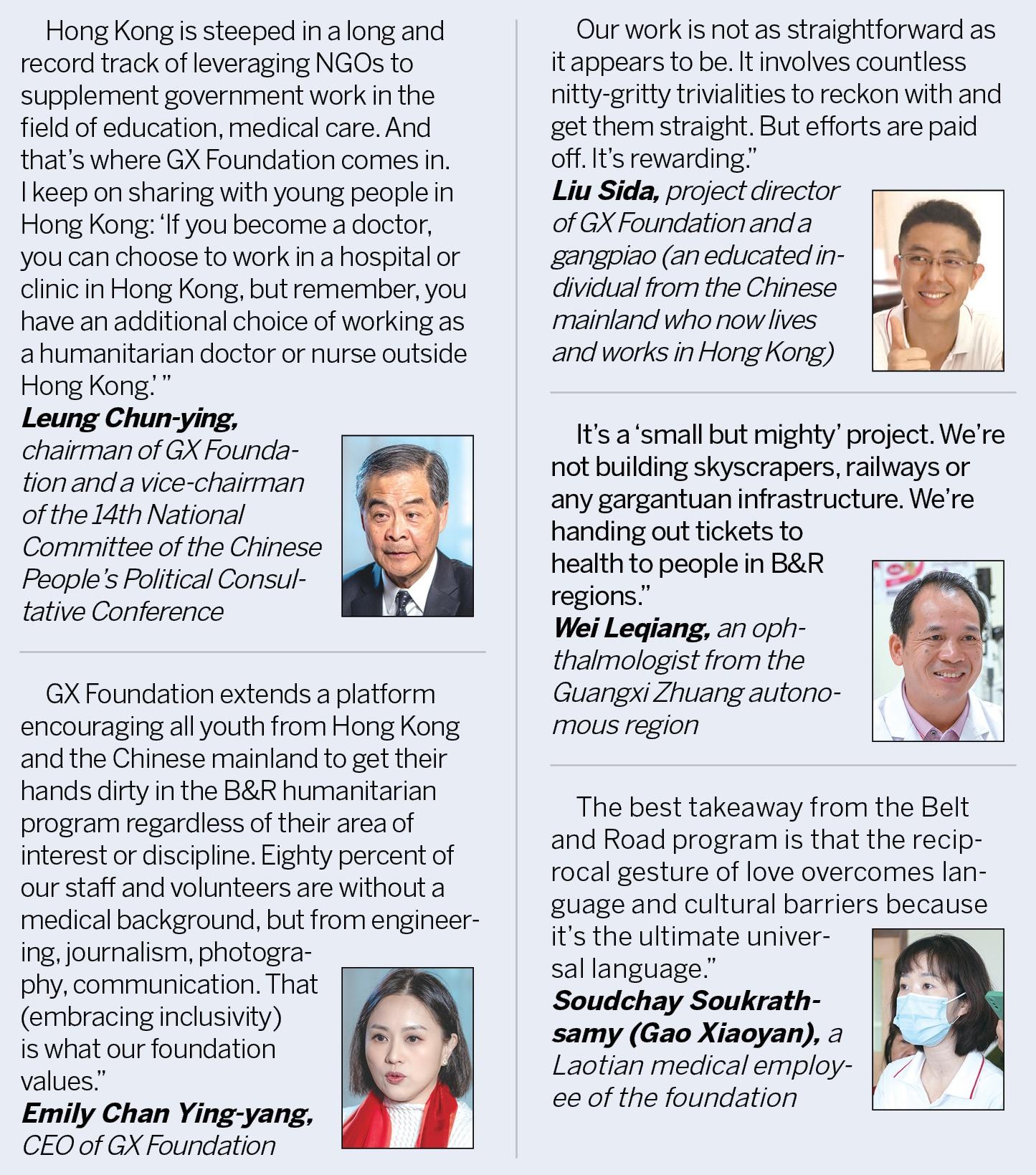Hong Kong-based GX Foundation’s program to eliminate cataract blindness in impoverished countries in the Belt & Road Initiative has reached a milestone. Wang Yuke reports she was touched by the joy and jubilation of patients and their families who have experienced successful operations.
 The joy they feel thanks to their improving eyesight prompted patients to sketch a portrait of the reporter. (JIANG JIAXUAN / CHINA DAILY)
The joy they feel thanks to their improving eyesight prompted patients to sketch a portrait of the reporter. (JIANG JIAXUAN / CHINA DAILY)
Gingerly edging down a flight of stairs from a no-frills mobile operating room, parked under a sprawling canopy in the biggest hospital of the Laotian capital, Vientiane, scrawny yet petite Mai Tilathatkimkao, flanked by two Chinese medical employees, was beaming from ear to ear, her left eye covered in a gauze pad and her right eye exuding an ecstatic twinkle.
The 76-year-old picked up the pace a little, as much as her gaunt quivering legs could handle, as she couldn’t wait to embrace those waiting for her to “come out of the blurry shell” outside the makeshift surgery center. Caught off guard by her exuberant bear hug and radiant giggles, I found myself wrapping my arms around her bony shoulders. Her high-octane vigor of “rebirth” was just so infectious.
Tilathatkimkao — a frail Laotian woman, just over 1.4 meters tall, who had suffered from debilitating cataract blindness for years — was the 1,000th patient to have benefited from free cataract surgical operations performed in Laos by the Hong Kong-based GX Foundation. The foundation’s achievement marked a milestone in its Cataract Blindness Elimination Project aimed at clearing a backlog of cases in five countries involved in the Belt and Road Initiative, which was launched by President Xi Jinping in 2013. The organization launched its project in the region in September and has completed more than 2,000 cataract operations to help numerous patients regain their eyesight so far. It aims to hit its target of 9,600 in Laos, Cambodia, Djibouti, Mauritania and Senegal by the end of this year.
The landmark 1,000th operation performed on April 24 also took a step closer to the medical “holy grail” set by foundation Chairman Leung Chun-ying: At the end of the day, the five countries will be able to stand tall and declare, “We’re free of cataract backlogs,” he said.
 Mai Tilathatkimkao (left) and her daughter.(JIANG JIAXUAN / CHINA DAILY)
Mai Tilathatkimkao (left) and her daughter.(JIANG JIAXUAN / CHINA DAILY)
No longer dreams
The milestone surgery was one of the thorniest and most herculean tasks for Chinese surgeon Wei Leqiang, as the elderly patient’s degenerative vision impairment had been left untreated for too long. Tilathatkimkao’s operation took 35 minutes — 10 minutes longer than usual, and one of the longest Wei had done since he joined the project.
We were given the privilege of observing the surgery through a glass pane inside the mobile treatment center, where a mounted monitor explained the whole procedure called phacoemulsification in visually granular detail. Tilathatkimkao was lying peacefully on a surgical table that was oversized because of her diminutive figure. The surgery was painless under local anesthesia, but her patience soon wore off as she began writhing, fiddling and murmuring. Wei swiftly lifted the scalpel, while three other Chinese and Laotian medical assistants rushed over, patting the restless patient with whispers, apparently to soothe her.
The makeshift surgery center, which was actually a van, was heavily sterilized and equipped, and rigorously calibrated to ensure it was absolute steady, Wei said. “When there’s even a slight tremor on board, I’ve to adapt to it accordingly, to create something like ‘sympathetic resonance’ (in physics). I’ve mastered it.”
It was a grueling wait for Thilathatkimkao’s youngest daughter, Pink Phetsamone, who was slouched against a chair as the clock ticked away. She had mixed feelings — uneasiness out of her occasional fidgety; and eagerness probably at the thought of her mother regaining her eyesight days after she drove her mother to the hospital on a motorcycle from their home on the outskirts of Vientiane.
“Having cataract surgery had always been on her mind since she first mentioned it to me three years ago,” Phetsamone said. There are ophthalmic clinics and hospitals in Vientiane providing cataract surgery, but it’s prohibitively expensive — 7 million Lao kip ($400) for the family, which ekes out a living through Phetsamone’s second-eldest sister, the sole breadwinner, who does ad hoc odd jobs on construction sites.
 Mai is the 1,000th patient to receive the surgery in Laos. (JIANG JIAXUAN / CHINA DAILY)
Mai is the 1,000th patient to receive the surgery in Laos. (JIANG JIAXUAN / CHINA DAILY)
“I couldn’t bring myself to tell her that I can’t afford it,” lamented Phetsamone, with a tinge of shame flashing across her face. She quit her menial jobs at Sanjiang Market — home to Chinese catering and retail businesses — three years ago to be her mother’s full-time caregiver. “I’m yearning to go back for work,” she bemoaned. “Since I’ve stopped working, I’ve become totally secluded, feeling like an outcast. No friends. No social life.”
“Mom had been pestering me every day about the surgery. She was desperate to see.”
Struggling to verbalize her frustration with blindness, her mother often threw tantrums. “It happened when she wanted to reach an object that she thought was in front of her but realized it wasn’t. She would be thrashing things around to vent her rage.”
GX Foundation’s humanitarian gesture of goodwill for the afflicted and impoverished people in the underdeveloped countries has been timely. Phetsamone came across a post on Facebook about the cataract elimination program. With faith in the Chinese medical team from the Guangxi Zhuang autonomous region — their skills and dedication — she made up her mind to travel all the way to the capital city’s downtown, hoping to restore her mother’s vision against all odds.
Phetsamone, 29, who is petite and lanky, became her mother’s round-the-clock “walking stick”. The duo’s inching along cross-armed or hand in hand at the tempo of her ailing mother’s limp was a touching sight at the hospital.
She had to keep her mother in sight every second to avoid any possible danger. Compounding her mother’s cataract blindness is dementia. “After a brain surgery in 2021, her mind started going awry. Her memory faltered. She couldn’t express herself properly. Eccentric behavior was common.” Her mental disorder had got her in trouble. “She had gone missing several times,” sighed Phetsamone. Blindness had put her mother in a more vulnerable situation and exacerbated her apprehension for her safety.
 Dr Wei Leqiang (behind the ophthalmoscope) performs a surgery. (JIANG JIAXUAN / CHINA DAILY)
Dr Wei Leqiang (behind the ophthalmoscope) performs a surgery. (JIANG JIAXUAN / CHINA DAILY)
Opening windows
“When the patients’ gauze pad was removed the morning after the surgery, it’s the moment of truth, the moment of revelation,” said Leung Chun-ying, emphasizing it’s a life-changing moment for cataract patients.
The eyes are the window to the soul. Deprivation of, or a blur on, the window would mean ties are severed with the outside world. Upon removing the gauze pad from the eye, patients can gain or regain more than eyesight — “independence in life”, said Leung. It’s nothing short of a reincarnation from a monochromic flat world to a kaleidoscopic lively paradise, where all human connections and kinships blossom, through the power of the eyes in reading souls and telegraphing affections.
“I (once) asked an elderly patient who was 70-something: ‘When you regain your eyesight, what’s the first thing you would like to see?’ ” recalled Leung. “He said: ‘I want to see my grandson who’s 5 years old. I’ve been blind because of cataracts for seven years.’ Put yourself in the grandfather’s shoes. You love your grandkid, but you’ve never been able to see him.”
“Light at the end of the tunnel” is synonymous with “hope”. When a life is shrouded in morbid darkness and forbidding unknowns, catching a glimmer of light or even the slight knowledge that someone is out there lending a helping hand is reassuringly emotional.
The long-awaited unveiling of gauze pads the next day at 6 am was akin to an epiphany, awash with nerves, suspense, anticipation and excitement. While the reactions of patients varied — their gravity of blindness, post-surgical swelling and ages differed — the majority reported notably improved vision. Sometimes, the “unveiling” ritual was festive, redolent of an old alumni party gathering.
We bore witness to the jubilee on the second day of our visit. Dozens of patients and their relatives gleefully sang and clapped in unison at the initiation of Maidee Tongnengyang, an industrious Laotian medical worker of the foundation who always exuded high energy.
Swept away by the contagious elation, I blended in the merry vibe, clapping along to their chorus despite my sheer ignorance of the lyrics and the song’s cultural relevance. But that seemed irrelevant whatsoever, as collective happiness out of people-to-people bonds dwarfed language barriers and cultural disparities. While I could contribute nothing to their choir, I counted myself lucky to be doling out my fair share of zeal.
A couple of elderly patients sharing a sprightly streak offered to sketch a portrait for me. While the results turned out to be unnamable creatures from probably some other unknown planets, invoking bursts of laughter, their masterpieces testified to their improved eyesight after surgery.
For Wei, peeling himself away from his responsibilities at hospitals in Liuzhou, Guangxi, for two months to devote his full time to the charitable cause in such an underdeveloped region, conceivably, calls for acclimation, but it’s “absolutely worthwhile”.
What Wei has been practicing is a nod to the saying “If you teach a man to fish, you feed him for a lifetime”.
“Delivering free surgeries is not a sustainable answer to Laos, where cataract blindness is rife, while delivering on-site training for local doctors is,” he said. Taking Wei’s advice, a Laotian doctor got the hang of it and has since become a sought-after practitioner.

Earning trust
Instead of being like other humanitarian aid and philanthropic campaigns whose team members are somewhat nomadic, Leung said teams working on GX Foundation’s cataract projects are stationed at one location for months, and are very involved from the start to the end.
What makes the operation a tall order is the pervasive ignorance of the fact that cataracts is actually curable in those underdeveloped regions, where the people are often undereducated with limited access to medical health information and resources, Leung said. Many would get cold feet with surgery, and are doubtful of the doctors’ ability, as well as the outcome of such operations.
Undeterred by such ignorance, Leung and the medical workers would often have a tete-a-tete with patients about the surgery procedures to build up their trust.
“Communication takes up a large part of our work, and it’s very important,” Leung said. “I often say, when you have the patient’s trust with the doctor, you’ll have about 95 percent of the work done. The remaining 5 percent is about the surgery.”
What have never erased from my memory are those gnarly, shriveled, tanned hands clenching mine, as well as those of all the other staff from Guangxi, the Hong Kong Special Administrative Region, and Laos itself. The strength of their grips offered a stark contrast to their vulnerability and helplessness before surgery. Such strength underlines the restored empowerment, resilience, security, conviction and hopefulness, which are all nourished, molded and grounded in friendship and mutual trust … in a timeless, borderless common thread linking the Belt and Road.
Contact the writer at jenny@chinadailyhk.com


